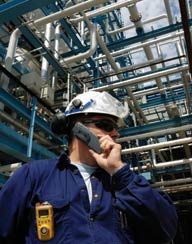By Mandy Sunderland, Senior Industrial Hygienist , Total Safety
 Turnarounds can be expensive in terms of lost production while the process unit is offline, and in direct costs for labor, tools, heavy equipment and materials used to execute the project.
Turnarounds can be expensive in terms of lost production while the process unit is offline, and in direct costs for labor, tools, heavy equipment and materials used to execute the project.
A well planned and executed turnaround helps ensure the project is conducted safely and efficiently, so the unit can be returned to operation as quickly as possible. Tremendous effort typically goes into planning and coordinating the various aspects to ensure all necessary repairs and maintenance are conducted during the turnaround, so the unit doesn’t have to be shut down again until the next planned turnaround. However, far too often industrial hygiene issues are not adequately addressed in the early phases of turnaround planning. Playing catch-up in this area can have a negative impact on worker safety, project budget and schedule.
To help ensure turnaround success, the following industrial hygiene items should be considered during planning:
- DETERMINE potential exposures to chemical agents well in advance and identify requirements for trained personnel and equipment. Based on potential exposures, the project may require IH devices such as real time direct reading instruments to measure agents such as total hydrocarbons or H2S. Personal and area air samples for laboratory analysis may also be required to measure specific agents in welding fumes or catalyst.
- DEVELOP clear guidelines for PPE (personal protective equipment) use throughout the project, including respiratory protection, hearing protection, gloves, coveralls and safety shoes. Access control plans should be developed to ensure workers aren’t exposed to hazards unnecessarily. Special attention should be given to any jobs involving confined space entry. Defining and communicating PPE requirements in advance helps ensure that contractors will provide proper equipment and trained personnel.
- DEFINE the types and numbers of worker and activities to be monitored. An IH sampling strategy should be developed which sets requirements for full shift TWA (time weighted average) sampling or activity specific STEL (short term exposure limit) sampling. Some operators monitor their own company employees, but require contractors to monitor their own workers. Coordinating these plans will help prioritize resources to better protect workers.
- UNDERSTAND the full scope and length of the turnaround. Determine if IH monitoring will be required during the preparation phase, actual shutdown, line breaks, vessel entries or start up and commissioning. Ensure adequate and appropriate IH materials, supply and support are available throughout the project.
- DECIDE which analytical laboratories will be used for IH samples. Agree on the types of reports needed (e.g. full report with specific recommendations or rough data only). Consider who will need to see results in order to keep the project running smoothly and maximize worker protection.
- ANTICIPATE the unexpected. Don’t get caught off guard by unexpected exposures to NORM (naturally occurring radioactive material), asbestos or PCBs. If you don’t have a clear picture of potential exposures, bring in an IH expert to conduct a survey of the project area and a review of the turnover plan.
In summary, a comprehensive industrial hygiene strategy will help ensure your next turnaround project is completed safely, within budget and on schedule. Therefore during your next turnaround planning cycle be sure to thoroughly examine industrial hygiene issues in your decision making process. It can save you bucks!
To learn more about Total Safety or our complete line of industrial hygiene services, contact us at 888.44.TOTAL (888.448.6825).
Total Safety – The Best Minds in the Business!








